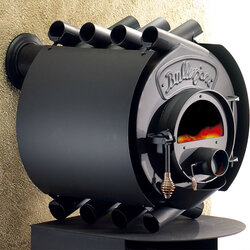Regarding the EPA rated stoves, a couple observations. I've been heating with wood for 40+ years. My first stove was a steel barrel and as a newly married man in a small cottage it kept us alive and quite warm. Then I got a Vermont Castings Elm, which I still have and I love that one. Then we got a fancy Rais and Whittis from Denmark, and finally an EPA rated Vogelzang from Tractor Supply Co (it was the biggest one I could find at the time).
The Vogelzang has a ceramic blanket a couple inches under the top plate and side ports to admit air into a stainless steel liner for secondary burn and it works. After a year with this thing in a large 1000 SF living room with 22-foot ceiling and fan, with about 30-feet of six foot high insulated glass, I just was not all that impressed with the amount of heat it was putting out. It was better than the Rais due to the fact it was a bigger firebox, or so I thought. One day as the stove was cranking out with a 600-degree reading on the top plate, I noticed the double wall side panels were putting out practically nothing, could almost touch it with a bare hand, meaning it was probably around 150 maybe upwards into 190 ish, and the outdoor flue (double wall stainless) was really hot (in fact the outdoor flue was hotter than the side of the EPA stove I was trying to heat my house with).
I have come to the conclusion that the EPA stoves are very well insulated to burn hot inside the stove and reduce emissions, but there is way too much heat going up that flue. I removed the metal side panels on the stove and it allowed a little more radiation into the room. I then removed the side firebrick, retaining bottom and rear firebrick, and now I am getting readings of 400-degrees or slightly more off the sides of the stove, it's putting out much more heat, and the outdoor flue is not as hot any more. It's actually performing more like the Vermont Castings round chamber stove where the bare metal radiates so much heat. I am sorta disgusted knowing how much work I put into cutting trees, hauling logs with the tractor, cutting them up and splitting and stacking, knowing the fancy EPA stove was just eating up wood for the sake of lower emissions.
Since this stove sits in a room with nothing near it on either side, I'm not concerned about side clearance. I am pleased with the added heat. I will probably add the firebrick and side panels next time it cools down for a cleaning, and will run it again as a comparison. I have been burning cherry, black tupelo, locust, poplar, and some elm, each wood having a purpose for when it is used.
I would appreciate any other observations of this kind regarding the blanket EPA secondary burn stoves. Please save code related commentary, my professional background is not void of an understanding of those issues, I'm just looking for real world hands-on comments. Many thanks,

 , but I do know my trees!
, but I do know my trees!

 And I do have 8 full cords on hand cut to that size ... the thought of shortening those up is daunting to me.
And I do have 8 full cords on hand cut to that size ... the thought of shortening those up is daunting to me.